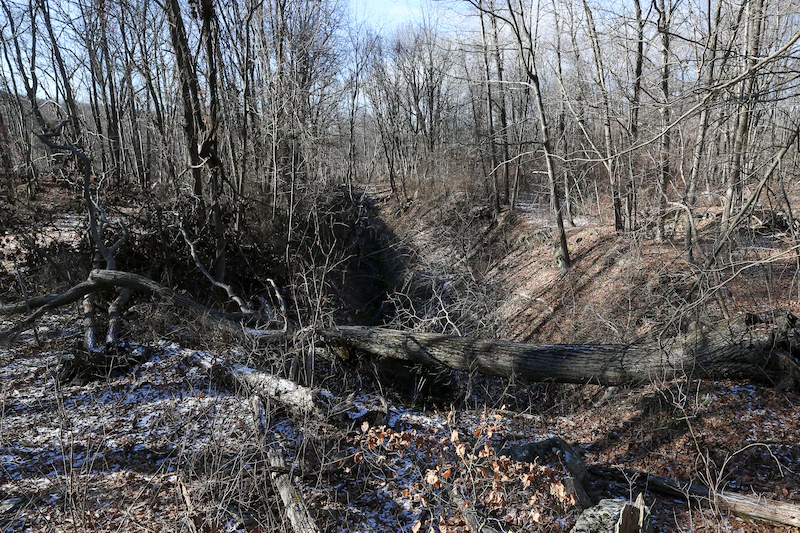
Nearly 600 abandoned mines are hidden beneath N.J. towns.
When an abandoned mineshaft beneath Interstate 80 in Morris County collapsed the morning after Christmas, closing the eastbound side of the highway for four days, everyone took notice.
No vehicles crashed and no one was injured when the remains of the long-abandoned mine crumbled. But, for many, the sinkhole provided a sudden, alarming awareness that New Jersey is home to long-closed mines that can, and sometimes do, instantly collapse into a crater without warning.
“They’re everywhere,” said Timothy Rack, safety and compliance manager for the Morris County Parks Commission.
Abandoned mines on Morris County Parks land are surrounded by fencing and highlighted by blunt “danger” signs reading, “stay out, stay alive.”
Other mines around the state are more hidden.
There are approximately 588 mines beneath the surface in nine northern counties, mostly in a band across hilly northwestern New Jersey. They include the old mine that caused the I-80 sinkhole last month in Wharton, according to a map provided by the New Jersey Department of Environmental Protection.
All 588 mines abandoned in New Jersey
New Jersey has 588 abandoned mines, with a median age of 160 years old. Click on each dot to see more information about the mine. (Note: Not every county in New Jersey has a recorded abandoned mine.)
Some mines are in unexpected locations, including a copper mine in Edison — opened in 1784 and last used in 1903 — that is not far from NJ Transit’s Metropark train station in Middlesex County. Others date to before the Revolutionary War, including a mine in New Brunswick identified only as a French mine that opened in 1750.
Most were last in use more than a century ago. The Bolmer mine, one of the four mines in Bridgewater in Somerset County, was decommissioned in 1868.
Occasionally, a sinkhole forms when a mineshaft collapses, which is what happened when a 40-foot-deep hole opened up on the eastbound I-80 highway shoulder in Wharton on Dec. 26.
While a tragedy that day was averted, sinkholes attributed to abandoned mines have occasionally proven deadly for generations, in New Jersey and elsewhere.
In November 1963, a 15-year-old boy was playing with two friends in Ringwood in Passaic County when he fell an estimated 100 feet into an abandoned iron mine and was buried under a series of cave-ins that lasted for an hour, The Star-Ledger reported at the time. The collapse was so extensive that authorities gave up trying to recover the teen’s body.
More recently, in western Pennsylvania on Dec. 2, a 64-year-old woman searching for her missing cat died after falling into an abandoned mine through an opening that was about the size of a manhole cover, authorities said. Her body was recovered four days later.
The mayor of Mine Hill, a Morris County borough whose name stems from two centuries of iron ore mining in the area, said he hopes the I-80 sinkhole will raise awareness and perhaps lead to additional state funding for mine mapping and other measures.
Mayor Sam Morris said Mine Hill has around 16 dormant mines, some of which occasionally prove problematic. A three-foot wide sinkhole formed near the playground at the Canfield Avenue School around two decades ago, but no one was hurt, he said.
In 2004, a water-filled sinkhole 15 feet deep was discovered by a worker near a Department of Public Works salt shed. A Mine Hill resident in 2016 reported a crater, 19 feet deep and about 20 by 30 feet wide, on his property near the entrance of an old ore mine.
“This is a very real and scary issue. I’m hoping that Route 80 will bring this issue back to light,” Morris said.
Abandoned mines are not just a New Jersey problem. There are up to 500,000 in the U.S, according to the federal Mine Safety and Health Administration.
In an incident mirroring what happened on I-80, Route 185 in Illinois was closed for about a month last summer as workers filled in a 50-foot sinkhole, attributed to an abandoned mine, in a field just off the highway.
Fixing mine-induced sinkholes is expensive. In 1989, a recurring problem with sinkholes in North Arlington in Bergen County resulted in 27 mineshafts being capped at a cost of $1.4 million under a federal program that was abolished seven years later, the Jersey Journal reported.
It wasn’t a total fix, though. A sinkhole developed between two North Arlington houses in 2003, which was blamed on a shaft leading to a copper mine dating to around the Revolutionary War.
While many abandoned mines in New Jersey are filled in, state law requires only fencing around the locations. That was not an option for the now-repaired I-80 sinkhole, which happened in Wharton just west of the Route 15 interchange.
The state Department of Transportation “is reviewing the area to further assess the stability of the subsurface conditions,” said Steve Schapiro, a department spokesperson.
“During the emergency repair, we performed Ground Penetrating Radar and found nothing of concern,” Schapiro said.
One environmental activist told NJ Advance Media he state should proactivity pursue geotechnical investigations to get ahead of developing sinkholes.
“We don’t necessarily know where the sinkholes are or where they might be forming,” said Elliott Ruga, policy and communications director for the New Jersey Highlands Coalition.
Ruga said it was “just a stroke of luck” that I-80 incident was not environmentally catastrophic.
“A tractor trailer loaded with gasoline that spills into a sinkhole, that goes right into the groundwater,” Ruga said.
While entrance locations to mines usually have been mapped, their extent underground often is not know, according to Rack.
“A lot of times, you don’t know where they are. That’s the biggest problem. They would dig straight down, then they would go left or right,” Rack said.
There are warning signs for the Dodge Mine off Weldon Road in Jefferson, a heavily-traveled, two-lane road that connects with the high school, and middle school and police station.
Asked if the mine extends under the passing vehicles, Rack said, “It’s probably far enough off the road that it doesn’t, but again, who knows.”
A state Department of Environmental Protection map shows three abandoned mines next to the I-80 sinkhole location.
That the I-80 sinkhole cratered in early winter was not a surprise to Morris.
“They call it the freeze-thaw cycle. Sometimes that opens a mine hole. From this time until April, we hold our breath,” Morris said.
Sometimes a mine-related sinkhole, or the potential for one to develop, is spotted in time to avoid any real harm.
Rack cited the Schofield Mine in Jefferson, which was a steady source of iron ore until the late 1800s. It is located within the 3,000-acre Mahlon Dickinson Reservation, which attracts plenty of hikers and bicyclists.
The long-ago opening to the mine had been secured beyond a fence when, about a year ago, he said he noticed a large hole about 40 feet deep within the fenced area.
“Just like Route 80,” he said.
Share to your favorite social media page
Follow Us
Fans
Fans
Fans
Fans


